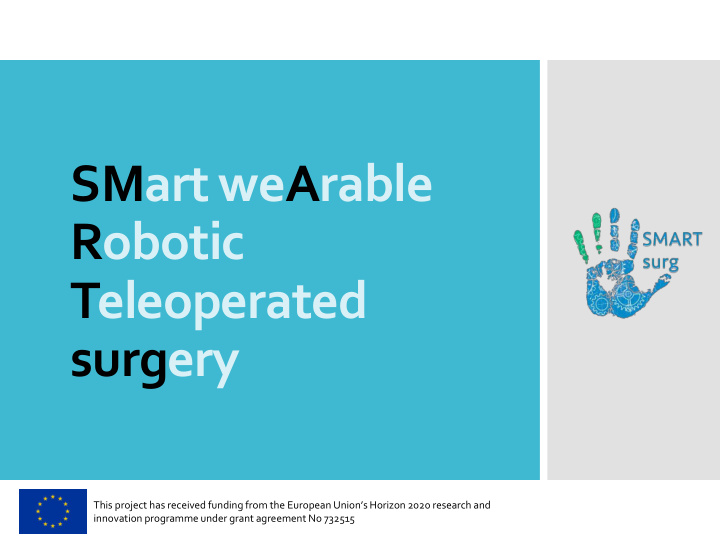



SMart weArable Robotic Teleoperated surgery This project has received funding from the European Union’s Horizon 2020 research and innovation programme under grant agreement No 732515
Context Minimally Invasive Surgery - MIS (a $50 billion market by 2019) has become an established alternative to the conventional open approaches due to its Effectiveness Patient satisfaction Teleoperated robotic surgical systems have been increasingly used in MIS procedures over the past ten years This increase is reflected in the use of service robotics for medical applications Medical Robotics correspond to 28% of the $5.2 billion market of service robotics 2
Motivation To assist and enhance further the surgeon’s performance during MIS we need to: Develop more sensitive robotic systems with new teleoperation interfaces: Improve their efficacy Expand their applicability to more complex surgical procedures Develop advanced technologies that will reinforce R-A MIS dependability 3
Breakthrough SMARTsurg project aims to develop an advanced system for performing Robot-Assisted MIS that will: Reduce surgeon’s cognitive load (shorter training time) Increase accuracy and safety Reduce MIS procedure time Expand applicability A wearable surgical interface will be designed and developed: Highly dexterous anthropomorphic surgical instruments Wearable hand exoskeleton with haptic feedback for controlling the surgical instruments Wearable smart glasses for augmented reality guidance of the surgeon based on real-time 3D reconstruction of the surgical field Real-time dynamic active constraints will be applied restricting the surgical instruments’ motion to safe regions Short prototyping and testing cycles will be employed supported by focused end-user and commercial requirements 4
Objectives Develop a dexterous, adaptable, anthropomorphic surgical instrument Build a framework for providing haptic feedback from the surgical instrument to the surgeon Deploy strategies for dynamic active constraints construction and their guaranteed satisfaction Develop advanced cognition and perception abilities to achieve the real-time and on-the-fly reconstruction of the operation area Validate SMARTsurg project results in realistic scenarios involving procedures on different surgical domains 5
Vision 6
SMARTsurg System vs Existing Surgical Technologies 7
Impact Address healthcare issues that have a widespread applicability and at the same time reduce high cost on national healthcare systems Improve patient outcomes through a much wider offer of MIS Reduce surgeons’ effort by improving their ergonomics and information flow between them and the surgical field (through visualisation, haptics and novel controllers) Propose a cost-effective system that is built on top of commercial 6DOF robotic manipulators Provide a more dexterous, natural to use system with: Improved interfaces that would render fast learning and acceptance by surgeons Increased cognition abilities and dependability 8
Envisioned Use-Cases Use of phantoms and swine cadavers Urologic minimally invasive surgery Multiple quadrant surgery Prostate adenomectomy Partial nephrectomy Cardiovascular minimally invasive surgery Handling and suturing a cardiac valve Replacing a 0.5 to 3cm in diameter segment of artery Orthopaedic minimally invasive surgery Treatment of the meniscal tear injuries in the knee 9
Project Partners 10
More information smartsurg-project.eu Register to our newsletter @SMARTsurg info@smartsurg-project.eu Prof. Sanja Dogramadzi Bristol Robotics Laboratory University of the West of England Frenchay Campus, Coldharbour Lane Bristol BS16 1QY United Kingdom 11
This project has received funding from the European Union’s Horizon 2020 research and innovation programme under grant agreement No 732515
Recommend
More recommend